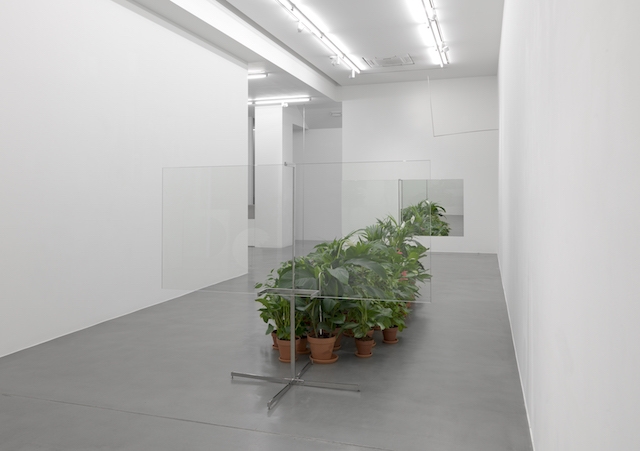It’s hard to imagine a more rudimentary, more starkly simple sculptural form than Luciano Fabro’s Squadra (Square, 1965–2001). A thin steel rod, about a metre-and-a-half long, juts perpendicularly out from the gallery wall, supporting at its outward end a second, identical rod, positioned upright so as to almost reach the gallery ceiling. Together, the two segments look like a kind of elemental line drawing in space – like, indeed, two sides of a square, or a diagrammatic representation of a right angle. Except that, actually, the arrangement isn’t precisely rectilinear, because the structure sags slightly under its own weight, the vertical rod producing a downward torque in the horizontal one – that’s the reason the topmost point doesn’t quite touch the ceiling as it otherwise would. And so the work, rather than being about purity of form, ultimately relates to an opposite notion – the fallibility of matter and the way that idealisations have a tendency to become warped or distorted when materially realised.
Fabro would go on to expand upon this theme with what are probably his best-known works, his large, sculptural reliefs of the Italian map produced in gold, bronze, even leather – sumptuous-looking pieces that were made under the auspices of the arte povera movement, with its emphasis on the associative poetry of materials. The works in the current show, however, stem from a prior, pre-arte povera phase (though all were remade by Fabro during the last decade of his life), and are more directly concerned with phenomenological matters, with the here and now of the gallery space.
The works come in two sorts: Metalli (metal works) and Vetri (glass works). The former group consists of rather spare-looking, rod-based pieces, including Squadra and also a companion piece, Ruota (Wheel, 1964–2001), in which another wall-anchored armature supports a hoop whose circumference is of equal length, the horizontal element again bending slightly under the load. But other Metalli constructions are less the result of physical forces than they are deliberately crafted – such as the vast, freestanding Croce (Cross, 1965–2001), whose four vertices are fractionally misaligned to each other; or Asta (Pole, 1965–2001), a long, pointed pole apparently suspended straight from the ceiling, but which actually deviates from true verticality by a single, barely perceptible, degree. And questions of perception are similarly at the heart of the Vetri pieces. Buco (Hole, 1963–2005), for instance, is an upright sheet of glass decorated with a transparent, latticework pattern, while the background areas remain mirrored – so that looking simultaneously at and through it creates a dissonant, discombobulating effect.
The centrepiece of the exhibition, though, its most enjoyably complex exploration of the act of looking, is a combination of two Vetri and one Metalli, which Fabro originally brought together as an installation in 1992. Tubo da mettere tra i fiori (Tube to Place Among Flowers, 1963–2001) consists of a dense arrangement of pot plants covering the floor, whose lush foliage semiconceals a horizontal pole running the display’s length. At one end of this greenery is Tutto trasparente (All Transparent, 1965–2007), a rectangle of transparent glass held aloft on a metal stand – so that what’s ironically being presented is the opportunity to look past the pane, to consider instead the garden scene beyond. At the other end, Mezzo specchiato mezzo trasparente (Half Mirrored Half Transparent, 1965–2007) is the same setup, except with half the glass surface reflecting additionally what’s behind the viewer. Tellingly, the panes are in landscape format, implicitly invoking the history of framing views of nature – of nature, that is, being regulated by the suzerainty of the gaze, quite as much as through the domestication of plants. At the same time, though, the long sag of the central steel pole reminds us that, ultimately, the determination of natural forces remains something beyond our control.
Luciano Fabro at Simon Lee Gallery, London, 30 November – 11 January
From the January & February 2018 issue of ArtReview
